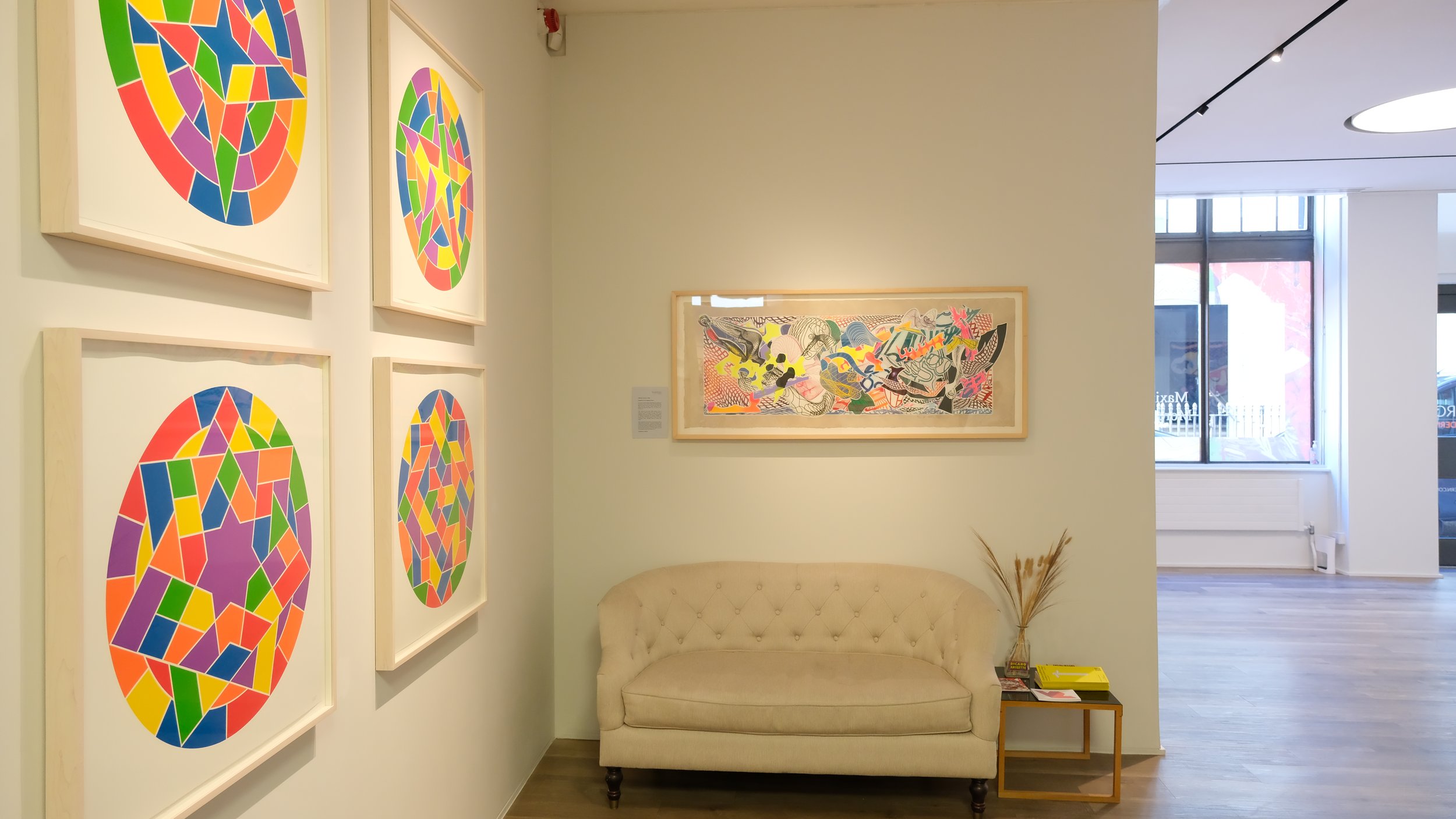Maximalism: More is More at Shapero Modern
art, exhibition

Front view Shapero Modern Gallery, Maddox St London Photo. Shapero Modern
Maximalism, the celebration of excess in art, emerged as a reaction to the Minimalism trend of the 1960s. Artists enthusiastically embraced the idea of overwhelming their canvases and printing plates with an abundance of techniques, materials, and colors. The ethos of ‘More is More’ shines a spotlight on the aesthetic principles championed by the key figures of Maximalism. These artists were driven by a desire to shatter the confines of Minimalism's conventions.
Maximalism finds its origins intertwined with Neo-Expressionism, a movement that defiantly countered the stark simplicity of 1960s Minimalism. As the late 1970s rolled around, luminaries like Frank Stella, Sam Francis, and Harold Cohen embraced vibrant and varied color palettes while fusing diverse ideas and concepts within single artworks. For this select group, Maximalism evolved into a tool for expression, harnessing the tension arising from clashes between contrasting colors, patterns, and shapes. Their works stood as dynamic opposition to the subdued and understated palettes of Minimalism.
The onslaught of Maximalism posed a challenge to the established norms of abstract art, drawing inspiration from the burgeoning multiculturalism of the Western world. Consequently, Maximalist art frequently incorporates techniques, materials, and imagery from non-Western artistic traditions. In certain instances, artists seamlessly weave striking patterns from Indian textile heritage into abstract compositions reminiscent of American Abstract Expressionism. British artist Howard Hodgkin's collection of Indian art, coupled with his firsthand experiences in the country, wielded considerable influence over his Maximalist creations.
Maximalism embraces the intricacies of artistic creation, a complexity Minimalism aimed to downplay, by amalgamating and layering mediums, patterns, and forms. In contrast to Minimalists like Donald Judd, who distilled art to fundamental geometric elements, Maximalists seek to expose the inherent intricacies of artistic concepts through an amalgamation of diverse styles and techniques. The artists highlighted in this exhibition—Frank Stella, Robert Rauschenberg, Sam Francis, Harold Cohen, Pia Fries, Ivor Abrahams, Sol LeWitt, Howard Hodgkin, and William Tillyer—may diverge in their approaches, yet they are unequivocally bound by their pivotal roles within the Maximalist movement.


LeWitt, Sol, Tondo Stars, 2002, center

Stella, Frank, Atvatabar I, 1995, right
Francis, Sam, Senza Titolo III, 1987 left

Cohen, Harold, Untitled, (Pink), 2005, right
Francis, Sam, Trietto 4, 1991, left

Stella, Frank, Despairia, from Imaginary Places, 1995
Visit Gori Mora's London exhibition to explore surreal art that delves into queer identity and intimacy, featuring unique oil on perspex techniques.
Damian Elwes' collection invites viewers into the intimate studios of renowned artists, blending meticulous research with personal narratives to illuminate the creative process.
Yinka Shonibare returns to London with "Suspended States" at Serpentine South, his first solo institutional exhibition in over 20 years, featuring two major new works: Sanctuary City and War Library.
How Far I Would Have to Go to Become Myself, traces his personal journey of self-discovery, blending themes of family, cultural identity, and queerness.
This show offers a unique glimpse into Goldin's personal narratives, celebrating cultural diversity, LGBTQ+ representation, and the transformative power of technology in art.
The artist invites viewers to reconsider their perceptions of authenticity, presence, and the evolving role of the artist in a technological world.
His pieces, often inspired by nature and primitive art, evoke a timeless simplicity that resonates with the soul.
Explore the profound influence of Surrealist aesthetics and conceptual themes on modern art.
Inspired by Vilém Flusser and Anna Atkins, this exhibition showcases innovative techniques, including wet-plate collodion photographs and dynamic generative software, revealing the intricate blend of the natural and artificial worlds.
Experience the liminal spaces where reality meets illusion, and delve into the depths of human consciousness with von Brandenburg's enigmatic creations.
From fragmented motifs to surrealistic narratives, Oehlen's paintings defy convention, inviting viewers on a journey of visual discovery.
Pim challenges established power dynamics within art, offering a fresh perspective on history and cultural heritage.
Through immersive installations and dynamic compositions, Othello's work reflects a deep reverence for clay and its connection to ancestral traditions, offering a unique perspective on the transformative power of art.
‘The Cluj Collective’ brings together seven Romanian artists, all alumni of the esteemed University of Arts and Design Cluj-Napoca in north-western Romania, a pioneer in visual arts in the region.
Witness the UK premiere of "Living Archive: Large Nature Model," a mesmerizing fusion of AI imagery and ecological data, alongside sensory experiences like "Artificial Realities: Coral" and "Artificial Realities: Rainforest."
Hailing from Somalia and nurtured in Kenya, her migration to Denmark during adolescence and later to the vibrant cosmopolis of New York City imbued her visual lexicon with a kaleidoscope of influences.
Tempus is an immersive and groundbreaking art exhibition in Mayfair, featuring multidimensional works exploring themes of time, energy, and craftsmanship.
Wurm disrupts traditional distinctions between subject and object, the human and the non-human, spectator and participant
In essence, the 'Laugh Now' exhibition at the Moco Museum celebrates Banksy's influence and the transformative power of street art, underscoring its relevance in contemporary discourse.






















This show tells the story of Rapha by showing important events from its history, and shares ideas about where cycling is heading in the future.